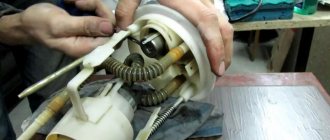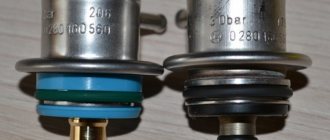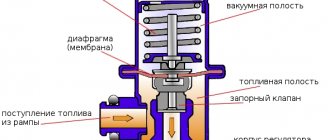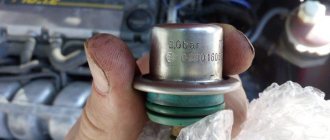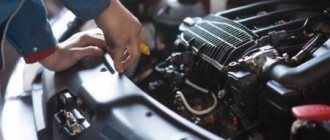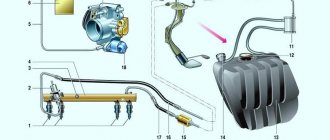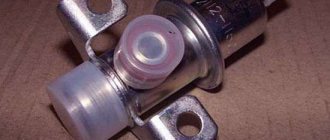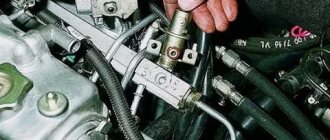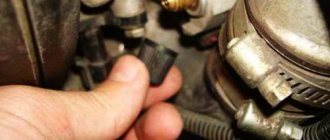Malfunctions of the fuel pressure regulator lead to the fact that the engine starts with difficulty, has a “floating” idle speed, the car loses dynamic characteristics, and sometimes fuel leaks from the fuel hoses. As a rule, a fuel pressure regulator (abbreviated as RTD) is installed on the fuel rail and is a vacuum valve. In some car models, the RTD cuts into the fuel return hose of the fuel system. To determine that the fuel system malfunction lies in a faulty pressure regulator, it is necessary to carry out a series of simple checks.
Checking the pressure in the engine power supply system
The pressure in the fuel rail can be checked with a conventional pressure gauge (for example, from a tire pump).
We carry out the work on a cold engine. Relieve the pressure in the engine power supply system (see “Replacing the fuel filter”). Remove the plastic engine screen. We put an oil and petrol resistant reinforced hose (with an internal diameter of 12 mm) onto the threaded fitting of the pressure gauge and secure it with a clamp. Unscrew the plastic cap of the fitting on the fuel rail
Using the wheel valve cap, unscrew the spool valve from the fuel rail fitting. We put the pressure gauge hose on the ramp fitting and secure it with a clamp. We put the wire on the “negative” terminal of the battery. Turn on the ignition. In this case, the fuel pump should turn on, the operation of which can be monitored by ear.
We measure the fuel pressure in the system... ...which should be 3.6–4.0 bar. After stopping the pump, the pressure may decrease slightly and then stabilize for a while. If the pressure in the system is more than 4.0 bar, the fuel pressure regulator is faulty. Low but stable fuel pressure in the power system can be caused by a clogged fuel filter or fuel module strainer, as well as a malfunction of the fuel pump or fuel pressure regulator. To check the fuel filter for contamination, you must remove it (see “Replacing the fuel filter”), drain the remaining fuel from the filter and blow it through a piece of hose (you can use your mouth). The resistance to air passage during purging should be insignificant. Otherwise, we replace the fuel filter with a new one, which we recommend always keeping in stock. We check the condition of the fuel module strainer after removing and disassembling the module (see “Removing and disassembling the fuel module”). If the mesh filter is very dirty, clean and rinse it. If the fuel pressure in the engine power supply system is low and continues to drop after the pump is turned off, this may be due to leaky fuel module connections, a pump malfunction, or leaking injectors. To find the cause of the malfunction, turn on the fuel pump again, and after stopping it, completely pinch the rubber hose supplying fuel to the fuel rail. If the pressure stabilizes, then the fuel module is leaking or the pump is faulty. If the pressure continues to drop, one or more injectors are leaking. A leaking injector can usually be identified by the dark color of its nozzle, which contains coked droplets of fuel. To check the serviceability of the fuel pressure regulator, connect the pressure gauge hose directly to the outlet fitting of the fuel module. Turning on the ignition, measure the fuel pressure. If the fuel pressure in the system is low but stable, the regulator is releasing pressure too quickly and needs to be replaced.
Removing and disassembling the fuel module
We are carrying out work to replace the fuel level indicator sensor, fuel pressure regulator, strainer and fuel pump.
Relieve the pressure in the power system (see “Replacing the fuel filter”). Disconnect the wire terminal from the negative terminal of the battery. Inside the car, lift the rear seat cushion (see “Removing the rear seat”) and bend the sound insulation valve that closes the hatch cover in the floor of the body under the rear seat. Use a Phillips screwdriver to unscrew the two screws securing the hatch cover...
...and remove the cover. Lifting the wire harness block clamp...
...disconnect the block from the fuel module cover connector.
By pressing the spring clamp, disconnect the tip 1 of the tee from the fitting of the fuel module cover. By squeezing the clamps (in the direction of the arrows) of tip 2 of the fuel supply tube, disconnect the tip from the fitting of the fuel module cover.
Using a 10mm socket with an extension, unscrew the 8 nuts securing the pressure plate of the fuel module. Remove the spring washers and the ground wire from the tank neck studs.
Remove the pressure plate.
Carefully, trying not to damage the fuel level indicator sensor float, remove the fuel module from the tank. We drain the remaining fuel in the module into a previously prepared container.
If replacement is necessary, remove the ring plastic spacer.
Please note: when installing the spacer subsequently, its cut must coincide with the protrusion on the fuel module cover.
Remove the rubber sealing gasket. We close the hole in the fuel tank to prevent foreign objects from getting into it. We disassemble the fuel module on a workbench. If it is necessary to replace the o-rings of the fuel pressure regulator or the regulator itself...
...disconnect the tip of the ground wire from the terminal on the regulator body.
Using a screwdriver, remove the fuel pressure regulator mounting bracket.
Using pliers, remove the regulator from the module cover socket.
Remove the two rubber sealing rings of the regulator. Install the fuel pressure regulator in reverse order. We replace the regulator O-rings with new ones. Before installing the regulator O-rings, apply a thin layer of engine oil to the O-rings. To replace the fuel gauge sensor or fuel pump, the fuel pressure regulator does not need to be removed. From the inside of the module cover...
...use a screwdriver to press out the fixing plate of the common wire block...
...and disconnect the wire block from the cover connector. By pressing the latch...
...disconnect the wire block from the fuel pump. To remove the fuel level sensor...
...we release the two sensor latches...
...and move the sensor along the grooves of the housing towards the cover.
Remove the fuel level indicator sensor with wire blocks. Install the fuel level indicator sensor in the reverse order. When replacing the fuel pump, it is better to remove the fuel level sensor to avoid damaging it.
Use a screwdriver to pry up the drain tube... ...and disconnect it from the module body.
There is a retaining ring located in the groove of one of the guide posts of the module cover. We remove it by prying it with the blade of a slotted screwdriver.
By pressing the four latches of the pump holder...
...remove the fuel module cover assembly with the holder and the fuel pump.
Remove the spring from the guide post of the cover.
...remove the strainer.
Remove the lock washer from the slot in the strainer housing.
Using a screwdriver, press out the plastic latch of the holder...
...and use your finger to push the fuel pump out of the holder. We heat the plastic corrugated tube on the pump nozzle over a container of boiling water...
...and remove the tube from the pump connection. The car is equipped with a BOSCH fuel pump 0580454035.
A valve is installed in the fuel module housing to prevent fuel from leaking out of the housing. We assemble and install the fuel module in the reverse order. When installing the strainer, pay attention to the condition of the lock washer; if it is dented, it must be straightened or replaced. When installing the fuel module into the tank...
...arrow 1 on the fuel module cover should be directed backwards (towards the trunk). Arrows 2 on the fittings of the fuel module cover indicate the direction of fuel movement. We put the tips of the tee and the fuel pipe onto the fittings of the module cover until the latches click. Before closing the hatch cover in the floor of the body under the rear seat, it is necessary to check the tightness of the fuel module connections. To do this, connect the wire terminal to the “negative” terminal of the battery and turn on the ignition.
Signs of a malfunctioning fuel pressure regulator
The fuel system of a modern car is a complex mechanism consisting of many parts and is one of the main systems. The fuel system contains many moving parts, one of which is the fuel pressure regulator. The flow of gasoline into the combustion chamber requires constant maintenance of a certain pressure, so this operation requires a special unit that is connected to both the combustion chamber (injectors) and the fuel system (via a valve).
However, over time, with constant and long-term operation of this unit, certain problems arise in the form of malfunctions, which can lead to certain problems in operation.
Components
This part consists of several main elements:
- The diaphragm valve is the main part of the regulator and is connected to the fuel supply system and the combustion chamber (injector rail). In most domestic models (such as VAZ 2115, 2110, 2114 and Lada Priora) this unit is presented in a similar configuration, since the fuel supply systems of front-wheel drive vehicles of this family have a similar design. Therefore, the quality of breakdowns for these machines is similar;
- Pipes connected to the valves and combustion chamber on one side and, through other valves, to the fuel line on the other. The device in the VAZ 2107 models is somewhat different due to an older and unreliable design. When using equipment for rear-wheel drive, old components of an outdated design are used (the valve may work unstable when operating in a carburetor engine and the wrong choice of fuel mixture enrichment) so its design is somewhat different, although problems arise.
Failure
The design of this unit is quite simple to operate, but the valve can also fail.
This will entail certain negative consequences and the main signs will be:
- Increased fuel consumption due to partial failure of the element . When the valve unstably performs its functionality, the pressure in the rail and the fuel system drops, there is an excess supply of gasoline to the combustion chambers, which causes significant fuel consumption. This also entails, in addition to increased gasoline consumption, increased wear of the element, which will ultimately lead to complete failure of the part;
- Unstable engine operation at idle speed . If the fuel supply is poor, the engine cannot reach its optimal level of operation, so the idle air regulator operates unstably. If there is insufficient pressure and the fuel pressure regulator fails, its supply either stops or fuel flows freely through the system. This can also cause the engine to start poorly, which requires increasing the load on the starter, also causing wear. This effect manifests itself during mechanical wear of the valve, when the failure of one part of it ensures poor pressure balancing between the fuel and air;
- The crankshaft cannot maintain a constant speed level. This effect is dangerous because this malfunction can involve many elements of the system, and the malfunction of this regulator is an indirect cause of such a breakdown. Unstable operation of the crankshaft not only disorganizes the driver, but also reduces engine life (albeit slightly);
- Deterioration of engine power qualities . If the fuel supply is poor, the engine cannot fully realize its potential when moving, so its performance decreases. This causes a deterioration in the dynamic qualities of the motor and affects its service life;
The video shows signs of a malfunctioning fuel pressure regulator:
What are the consequences of malfunctions in the operation of RDTs?
Over time, the engine starts more and more poorly. Fuel begins to come out of the cracks, which leads to a strong increase in its consumption. When the pressure changes unevenly, the dynamics of movement are disrupted, surges occur, and the car jerks during acceleration.
Is it possible to repair a failed part? In most cases, no, you have to completely change it. Repair units are almost always non-separable. Some experts suggest repairing the component, but this is dangerous. It is better to buy a new regulator - fortunately, it is inexpensive.
Determining violations in the operation of RTDs is not a very difficult task, which can be handled independently. Remember that this part of the machine needs to be checked periodically. By detecting the problem in time, you will protect important car components from rapid wear.
- Author: Dmitry Buimistrov
Hello! My name is Dmitry, I am a journalist by training. I specialize in automotive topics - I started my career in an online store of automotive components, and I myself am a car enthusiast. Rate this article:
- 5
- 4
- 3
- 2
- 1
(16 votes, average: 3.9 out of 5)
Share with your friends!
How does the fuel pressure regulator work?
Internal structure of the fuel pressure regulator: 1 - housing; 2 - cover; 3—pipe for vacuum hose; 4 - membrane; 5 - valve; A - fuel cavity; B - vacuum cavity
The fuel pressure regulator is a diaphragm valve, which in systems with fuel recirculation is installed on the fuel rail. Well, in systems where such recirculation is not provided, the RTD is placed directly in the fuel tank.
On the one hand, the fuel pressure regulator is affected by a special spring, as well as pressure in the intake manifold. On the other hand, it is pressed down by the fuel supplied by the pump. When the fuel pressure begins to exceed the spring pressure and the pressure acting on the valve from the intake manifold, the diaphragm valve opens, letting in the required amount of fuel, and as soon as the pressure of the supplied fuel decreases, the pressure regulator diaphragm closes.
In simplified form, it all looks like this. There are two chambers, fuel is pumped into one, and the spring is located in the other. The chambers are covered by a membrane, which opens at pressure values exceeding the action of the spring. It should also be said that in car models of recent years, such a regulator may not exist. Its functions are performed by a special electronic sensor that measures the voltage in the electric pump that supplies fuel. This solution allows you to optimally maintain the required pressure and regulate the fuel supply by directly controlling the pump. But, although such a system is more accurate, nevertheless, it is often a mechanical RTD that is much more reliable and lasts much longer than an electronic sensor, which is subject to various negative influences.
Design and operating principle
The regulator (RTD) consists of a housing, a valve, a diaphragm and a spring, which are located on the fuel rail, in the fuel return hose of the power supply system, or directly in the tank (if the car does not have a recirculation system). The purpose of the product is to send excess fuel back to the tank. When the engine speed increases, the resulting vacuum opens the valve slightly, and the excess returns to the tank.
Location of the fuel pressure regulator in the fuel supply system
Signs of RTD malfunction
Fuel pressure regulator for VAZ 2110
No matter how reliable a mechanical RTD is, over time its parts wear out and malfunctions and malfunctions occur in the operation of this unit. And now we will look at the main symptoms of such problems.
- increased fuel consumption;
- drop in engine power;
- Unstable engine operation at idle speed;
- jerks and dips when accelerating and changing gears;
- inadequate response of the car to pressing the accelerator pedal;
Let's consider the causes of the main problems of RTDs. First of all, you should check the condition of the spring. Over time, it may lose its elasticity, and as a result, the valve opens earlier than necessary. As a result, fuel is returned to the tank in larger quantities than necessary. The pressure in the system drops and the engine loses power. In this case, the spring should be replaced if the design of the regulator allows it.
Sometimes, especially when working with domestic fuel, the membrane simply becomes clogged and cannot close completely or partially. This again leads to a decrease in fuel pressure in the system and all the ensuing consequences. In such situations, again if the design of the RTD allows, cleaning can be done. But repairs do not always help, since wear of the valve and its parts can cause the regulator to not perform its functions fully even after the breakdown has been eliminated.
Less often, but still, situations occur when the fuel pressure regulator simply jams. In this case, the engine completely stalls, and fuel begins to flow from all possible and impossible holes. Repair in such cases is unpromising and a clogged regulator is easier to replace. But for the fuel pressure regulator to become clogged to the point of complete obstruction, there must be absolutely no fuel, since the system has a fuel filter that is designed to clean the fuel, and since it seriously fails to cope, it is better to change the gas station.
It is possible that the fuel pressure regulator valve becomes partially clogged and begins to operate jerkily. These jerks are transmitted to the operation of the engine and are perfectly felt by the driver, and even by the passengers of the car. In this situation, cleaning the RTD has a much better chance of returning its performance to an acceptable level.
In general, the electronic fuel pressure regulator is less susceptible to fuel quality and other mechanical factors that have a negative impact on this unit, but it also has its own weak points and characteristic vulnerabilities. On the other hand, if you don’t pour frankly bad fuel into the car’s tank, change the fuel filter on time and generally take care of the car, then any RTD will run for a very long time.
Electronic circuit for regulating fuel pressure
The fuel pressure in the system is adjusted using an electronic circuit, the design of which does not imply the presence of a mechanical regulator. The pressure in such systems is controlled by an electric fuel pump. The electronic control system installed in it records the voltage and regulates the volume of supplied fuel. The advantages of using a fuel pressure regulator sensor are maximum savings and reduced fuel heating.
Only a strictly limited amount of fuel is supplied to the engine injectors, necessary for the selected operating mode of the engine and the specific conditions of its operation. Excess pressure does not rise to a critical level due to the presence of a relief valve.
How to check RTD
As for checking the functionality of the fuel pressure regulator, in modern cars equipped with direct fuel injection, such diagnostics can be carried out exclusively using a pressure gauge connected between the fuel hose and the fitting. The instrument readings are compared with the standard pressure indicators for a given car model and based on this comparison, a conclusion can be drawn about the serviceability and functionality of the fuel pressure regulator.
But such diagnostics should be carried out by a qualified specialist, since there are a lot of subtleties and pitfalls here. Actually, only an experienced professional can make a decision about repairing or replacing the RTD. The effectiveness of repairing or replacing the fuel pressure regulator is also monitored using a pressure gauge. If you have an electronic pressure control unit installed, then it may need calibration or other fine tuning. But here, one pressure gauge will clearly not be enough, because the delicate electronics of a car require specific equipment and equally special skills to configure it.
Video about RTD
I’m driving quietly, enjoying myself, my favorite music is playing, suddenly I feel the car twitching, then everything is fine, it drives, the check engine light doesn’t come on, I thought it was a glitch and the road is not smooth) I drive into the yard, it stalls, I start it, it works, then it stalls again. I thought the pump had failed, checked it, it was working, but when I turned it on I could hear gasoline flowing into the tank through the return line, everything was clear) it was the fuel pressure regulator. Some people have it under the hood on the fuel rail and look like this
Let's look at the signs of fuel pressure regulator malfunctions
High fuel consumption Unstable crankshaft speed at idle Sudden engine stop at idle Poor engine dynamics and lack of power while the vehicle is moving High levels of CO and CH in the exhaust Difficulty starting the engine
The valve is completely inoperative - in this situation, fuel is not discharged into the tank and, as a result, the pressure in the fuel system increases. This pressure can be 3 - 5 kg/cm2 or more instead of the required 2.5 kg/cm2, which affects the amount of fuel entering the combustion chamber through the nozzles. The volume of fuel supplied through the nozzle at a pressure of 4 kg/cm2 will be greater than at a pressure of 2.5 kg/cm2, which will significantly affect its overconsumption. In this case, gasoline will not burn completely, since a complete combustible mixture should consist of one part fuel and 14.7 parts air
Replacement process for a 16-valve VAZ-2112
If the regulator is still faulty, we replace it in the following order:
- We disconnect the negative terminal from the battery for fire safety.
- Next, we reduce the pressure in the fuel system by unscrewing the nut that secures the fuel line and the RTD to each other.
To avoid fuel spillage, use a rag.
You will have to remove the bolts using hexagons.
Be careful when dismantling.
When connecting, pay due attention to the condition of the O-rings.
Attention! Before installing a new regulator, lubricate the O-rings with gasoline, so they will retain their elasticity longer and will be less susceptible to cracking.
Signs of a faulty RTD?
You can understand that the regulator is not performing its functions by the behavior of the car, and they are expressed as follows:
- When all systems are working properly, there may be interruptions in the engine idling . You will see unstable idle speed. And in some cases, the engine may stall completely when idling and also begin to stall.
- The crankshaft rotates either with increased or decreased frequency .
- The throttle response and dynamics of the engine have decreased significantly , and in order to gain the required speed, you need to apply more pressure to the gas pedal.
- Dips appear and jerk during acceleration, which greatly increases fuel consumption.
- It doesn’t happen often, but sometimes it happens that the engine does not start the first time .
All these reasons have one thing in common: during operation, the fuel pump releases much more gasoline into the system than required, as a result of which it does not burn out completely, which causes gasoline consumption to increase.
Fuel system diagnostics
We first learn about increased fuel consumption from the arrow on the instrument panel. However, on the VAZ-2112 it happens that it fails, or the fuel pressure sensor is lying. We advise you to read this article to be sure that this device is in good working order on your car, and to begin diagnosing the RTD itself as quickly as possible.
What do we pay attention to?
First of all, it’s time to inquire about the “health” of the fuel pressure regulator if the following symptoms attract your attention:
- The engine is extremely unstable. And it doesn’t “trouble”, as with problems with candles; the sound of the engine is uneven - not rumbling, but like a train rumbles at the junctions;
- At idle speed the engine may even stall. It is clear that this symptom is characteristic of many diseases: improper installation of the drive belt, flooded spark plugs, clogged carburetor... So if this is the only one present, you will most likely have to check many components;
- When driving, the engine runs jerkily and “sinks” are observed;
- abnormal consumption of gasoline (or diesel fuel). Again, a symptom can indicate different problems, so it is advisable to “make a diagnosis” based on the totality of symptoms;
- the level of carbon monoxide in the exhaust gases is exceeded (which is checked with an appropriate device or simply “by smell”);
- When switching to a higher gear, acceleration is weak and slow. The car loses its characteristic throttle response;
- the response to the gas pedal is delayed and weak (if this is not a characteristic feature of your car - for some VAZs and Chinese cars this behavior is quite normal).
If several of the described symptoms are detected, and the remaining components of the fuel system are normal, you will have to check the regulator itself.
Checking the RTD
In the old days, when driving exclusively in VAZs and GAZs, folk craftsmen came up with a universal “kneeling” method for self-checking that did not require any equipment.
Elementary actions:
the bypass valve was turned off/clamped and the outgoing stream was visually observed.
With the spread of injectors and carburetors becoming a thing of the past, the method became ineffective. (see “Differences between an injector and a carburetor”) Nowadays you will need a pressure gauge to check. However, a tire one, which almost every car owner has, is quite suitable.
The vacuum hose is removed, a pressure gauge is connected between the fuel hose and the fitting, the engine starts and idles. During the measurement, the pressure in the fuel system should rise from 0.3 bar to 0.7.
If this does not happen, the vacuum hose is changed and the measurements are repeated. This “knight’s move” did not help either - the problem is definitely in the fuel pressure regulator. It cannot be repaired, so we go to the spare parts store for a new one.
How to check on VAZ and foreign cars
To determine a breakdown, the following procedures are performed:
- The fitting plug is unscrewed - the element that controls the fuel pressure.
- The O-ring is inspected - if it is damaged, this component must be replaced.
- The spool is removed from the fitting.
- The engine starts, the pressure in the regulator is measured with a pressure gauge.
- The information received is compared with that specified by the manufacturer.
You can check the performance of the RTD yourself, even without tools. To do this, just pinch or disconnect the valve and study the intensity of the stream. A pressure gauge will give a more accurate result. It should be connected between the fitting and the fuel hose, having first disconnected the vacuum hose. The measurement is taken at idle speed. The information obtained depends on the car model - for example, in a VAZ 2110, the pressure indicator should start at 0.3 and gradually increase to 0.7 Bar.
Fuel pressure regulator with connected pressure gauge
Has your blood pressure changed? You may have connected the pressure gauge incorrectly. Check the connection. If everything is correct, it means the regulator has become unusable.
Where is the fuel pressure regulator located and how does it work (video)
Changing the RTD
- Those who are unsure of themselves can drive up to a service station with a new part, but believe me, nothing complicated will be required of you. Take a 24mm wrench and a five-point hexagon and begin the repair work;
- The fitting plug at the end is unscrewed. There is an o-ring there. If it is torn, cracked or stretched, replace the seal or the entire plug;
- The spool is unscrewed from the fitting. It is similar to the tire one, so you will recognize it;
- The vacuum pump is removed from the regulator;
- The nut is twisted - fastening the fuel drain pipe;
- The bolts are removed - 2 pieces - with which the RTD is fixed to the fuel rail;
- The regulator fitting is pulled out of the ramp hole, and the regulator itself is removed from the drain tube. It happens that the sealing ring gets stuck in the ramp. You need to carefully get it out of there; if intact, put it on a new RTD; if torn or cracked, replace it with a new one.
Installation of the purchased spare part is carried out in the reverse order. After finishing the installation, you should start it and listen to the engine to make sure that all problems are solved.
Finally, we note:
You shouldn’t raise the alarm and look for signs of a malfunction in the fuel pressure regulator as soon as the engine sneezes. RTD is a fairly reliable thing and does not “fly” very often. And if this happens, you will quickly understand what’s going on.
Operating principle of RTD
The valve design and operating principle depend on the type of fuel system of a particular vehicle. There are 3 ways to supply gasoline from the tank to the injectors:
- The pump together with the regulator is installed inside the tank; fuel is supplied to the engine through one line.
- Gasoline is supplied through one tube and returned through another. The fuel system check valve is located on the distribution rail.
- The circuit without a mechanical regulator provides for electronic control of the fuel pump directly. The system contains a special sensor that registers pressure; the pump performance is regulated by the controller.
In the first case, the return flow is very short, since the valve and electric pump are interlocked into a single unit. The RTD, located immediately after the supercharger, dumps excess gasoline into the tank, and the required pressure is maintained throughout the supply line.
Reference. The first scheme with a regulator inside the gas tank has been implemented on all Russian-made VAZ cars.
The second option is used in most foreign cars. A valve built into the fuel rail allows excess fuel to flow into the return line leading to the tank. That is, 2 gasoline pipes are laid to the power unit.
There is no point in considering the third circuit - instead of a regulator, there is a sensor whose functionality is checked using a computer connected to the diagnostic connector.
A simple fuel pressure valve installed in the fuel pump unit consists of the following elements:
- cylindrical body with pipes for connecting the supply and return lines;
- a membrane connected to a locking rod;
- valve seat;
- spring.
The amount of pressure in the supply line depends on the elasticity of the spring . While most of the fuel goes into the cylinders (high load on the engine), it keeps the membrane and valve stem closed. When the crankshaft speed and gasoline consumption decrease, the pressure in the network increases, the spring compresses and the membrane opens the valve. The fuel begins to be discharged into the return line, and from there into the gas tank.
The fuel pressure regulator installed in the rail operates on a similar principle, but reacts faster to changes in load and gasoline consumption. This is facilitated by connecting an additional pipe of the element to the intake manifold. The higher the crankshaft speed and the vacuum on the spring side, the stronger the membrane presses the rod and closes the passage of fuel into the return line. When the load decreases and the speed drops, the vacuum decreases and the rod releases - the return flow opens and excess gasoline begins to be discharged into the tank.
Faulty fuel pressure regulator: symptoms
The fuel pressure regulator is an element of the injection engine power system, which allows you to maintain the required fuel pressure in the fuel injectors at different operating modes of the internal combustion engine. In other words, the overall performance of the injectors and the stability of the engine depend on the serviceability of the fuel pressure regulator (FPR).
Considering that the pressure regulator is actually a diaphragm valve, failure of this element can greatly affect the operation of the engine. In this article we will look at the principle of operation of the regulator, highlight the main signs of its malfunction, and also talk about how to check the fuel pressure regulator.
Content
Signs of a malfunctioning fuel pressure regulator can be determined by hearing (some). Others manifest themselves in changes in the behavior of the machine. Naturally, such changes are by no means for the better. Therefore, as soon as they arise, you must immediately take appropriate action.
Why do you need a fuel pressure regulator?
As mentioned above, this regulator maintains the required fuel pressure necessary for normal operation of the injectors, taking into account one or another operating mode of the power unit. In other words, the RTD affects the amount and intensity of the fuel supply that enters the engine cylinders through the injectors.
Simply put, the amount of fuel supplied to the engine at the time of injection depends on the pressure that is created inside the fuel rail (rail), as well as on the pulse duration for opening the injector and the vacuum in the intake manifold.
For more accurate dosing and maintaining constant pressure, a diaphragm valve-regulator is used, which experiences fuel pressure on one side, and a spring force on the other. RTD is used in power systems where there is a so-called “return”. The regulator is installed at the fuel rail. Also, this element can be located in the fuel tank, while such systems do not have a return line.
- Let's first look at the common design in which the regulator is located in the fuel rail. The element operates on the following principle: the fuel pump forces fuel from the fuel tank along the line. The resulting fuel pressure acts on the regulator. The device itself has two chambers (a spring chamber and a fuel chamber), which are separated by a membrane. On one side, the membrane is pressed by fuel, which enters the regulator through special inlet holes, and on the other side, there is spring pressure and intake manifold pressure. If the fuel pressure turns out to be stronger than the spring force and the pressure in the inlet, then the regulator opens slightly, resulting in some of the fuel being discharged into the return line. The fuel returns through the return line to the fuel tank.
- In systems without a return line, the regulator is usually located directly in the tank. The advantages include the absence of an additional pipeline. The injectors are supplied with the required amount of fuel directly from the tank, that is, excess fuel does not enter the engine compartment, and there is no need to deliver it back to the tank. This also allows us to talk about less heating of the fuel and provides a number of additional advantages in the form of less intense evaporation.
Why is a control valve needed?
The fuel supply system of most passenger cars requires continuous operation of an electric fuel pump. It constantly pumps gasoline into the fuel line and ramp, raising the pressure to the maximum (5–7 Bar depending on the brand of car). But such performance is needed only under increased load on the engine, when it develops high speeds and consumes a lot of fuel mixture. In normal mode, a fuel pressure at the injectors of 3–3.5 bar is sufficient.
The fuel pressure diaphragm valve, installed in the engine power system after the fuel pump, performs 3 main functions:
- Limits the fuel pressure in the line at low engine loads, dumping excess fuel back into the tank through a separate tube.
- When the gasoline consumption of the power unit increases, the return flow is partially or completely blocked by the regulator. In this way, the valve maintains the minimum pressure required for normal operation of the motor.
- Maintaining pressure for a long time after stopping the power unit.
Without an RTD, the pump would “push through” the locking mechanisms of the injectors and gasoline would flow into the cylinders uncontrollably. In addition, the regulator protects the line from leaks at the connections, which will inevitably appear under the influence of strong pressure.
Fuel pressure regulator malfunctions
Problems in the engine power system can vary. For this reason, during diagnosis it is necessary to look for certain signs of a malfunctioning fuel pressure regulator. Most often, the main symptoms are considered to be when the engine does not pick up speed and does not develop full power, and also stalls in different operating modes. In the list of main signs, experts note:
- unstable operation at idle, the unit stalls at idle;
- loss of power, noticeable increase in fuel consumption;
- slow reactions to pressing the gas pedal;
- jerks and dips during acceleration, at the moment of throttling;
- the car does not accelerate, does not gain momentum;
Note that the malfunction of the RTD on gasoline cars is similar in symptoms to common problems with the fuel pump or its strainer. For this reason, when determining faults in the power system, a mandatory check of the fuel pressure regulator is necessary.
In other words, if the car stalls at idle, the engine power is lost, dips appear, the car jerks during acceleration or when changing gears, significant fuel consumption is noted, then the problem may not only be in the fuel pump grid, the motor or its relay, but also in the fuel pressure regulator.
Regulator malfunctions usually come down to the fact that the spring loses the required force, as a result of which the fuel is prematurely drained into the “return”, and the engine simply does not have enough fuel when you press the gas and increase the speed, as well as in transient modes. It turns out that the pressure in the fuel rail when the fuel pressure regulator spring is faulty is low, as a result of which the engine runs unstably, engine power decreases, the ECU is not able to correctly adjust the mixture composition for different operating modes, etc.
Failures in the operation of the RTD are also possible when the pressure regulator in the fuel rail begins to jam at certain intervals. In such cases, pressure drops occur in the fuel supply system, and the car begins to twitch. Let us add that the most common reasons for regulator failure, which results in signs of malfunction of the fuel pressure regulator on a diesel or gasoline car, also include wear and tear of the materials inside the device, that is, the valve simply wears out its service life over time. The service life and condition of the regulator are affected by the quality of the fuel and the content of various impurities in it, long periods of vehicle downtime without starting the engine, etc.
Replacing the fuel pressure regulator and mesh - logbook Lada Priora Sedan 2010 on DRIVE2
After a long period of inactivity, the car started very poorly and sometimes you turned it off, after a couple of hours it started again poorly, I bought a sensor and a fuel strainer at the same time, disassembled it and remembered about the fuel level sensor, it was stupid for me, the needle was jumping, but it was too late, the stores were closed, and again then because of it I didn’t want to remove the pump, even though it wasn’t anything complicated... I took a regular pencil eraser and cleaned it and now the sensor shows everything perfectly)
Full size
unscrew all the nuts by 10, disconnect the tubes and pull it out
.
Full size
disconnect the wires
old mesh
.
Full size
This is a new pressure regulator, before installing, lubricate the rubber bands with a little oil and install
We wash out all the dirt and assemble the pump)
I installed everything back) now it starts up much better) A couple more photos of my friend’s car, the car is really cool) Excellent condition)

